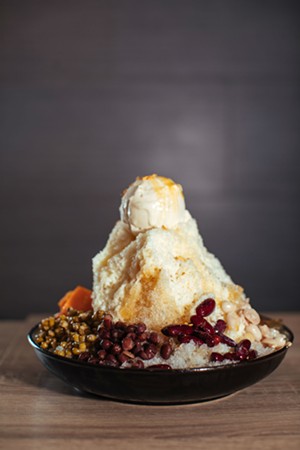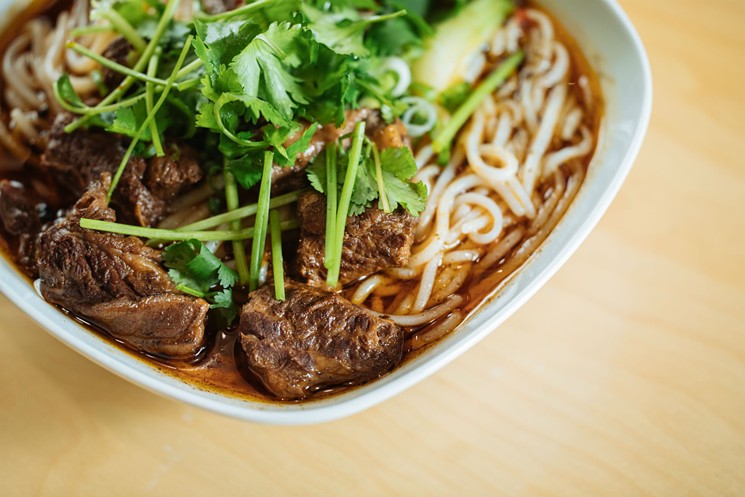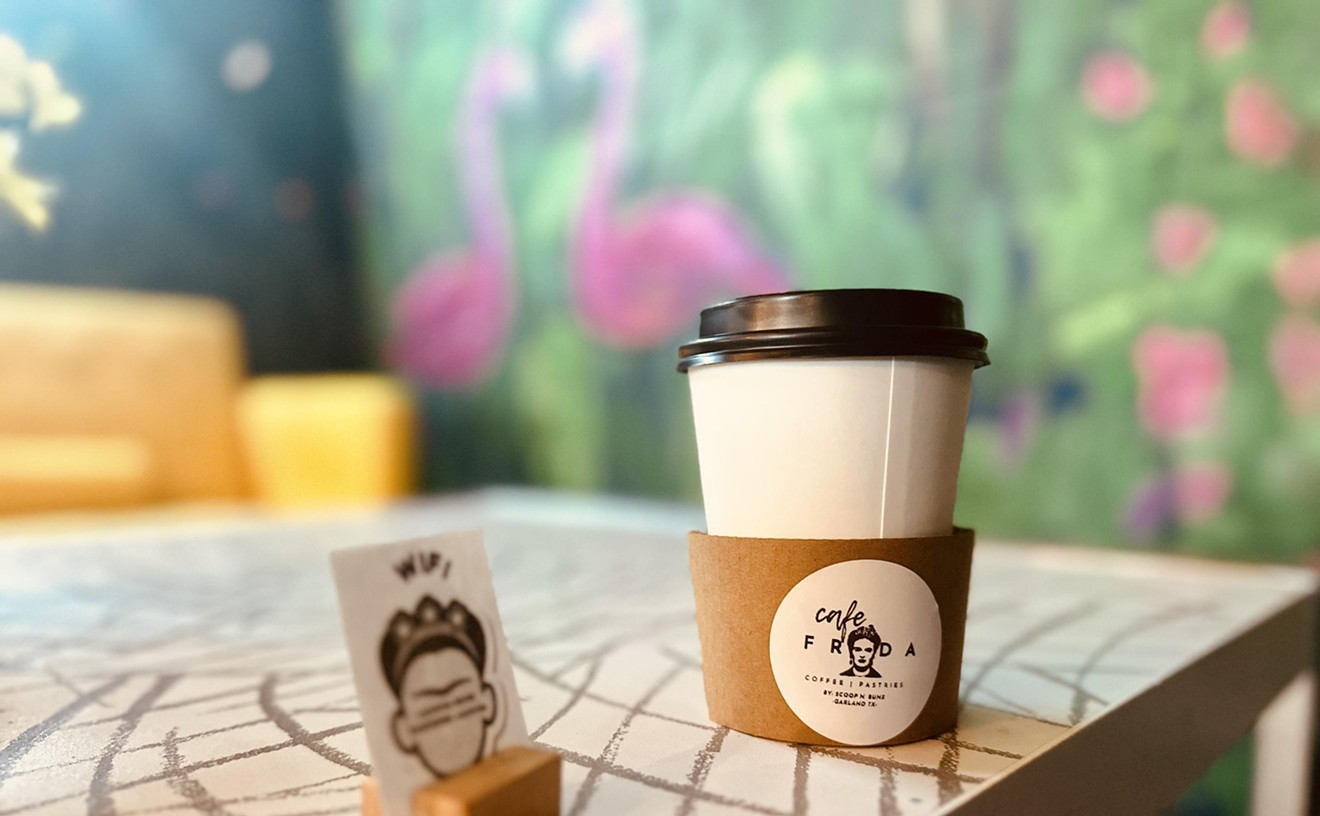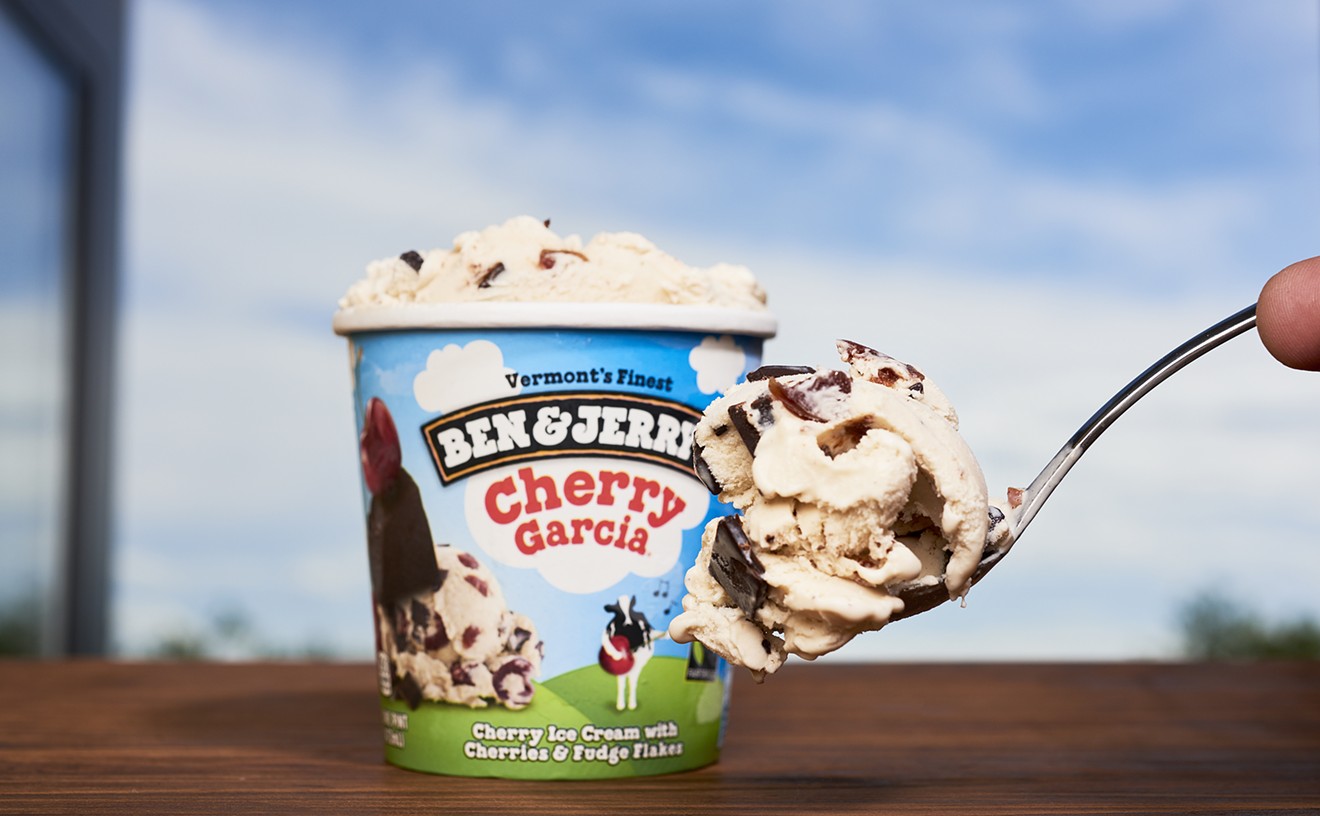One by one, the dishes arrived at the table. First, lamb and beef skewers. Then a plate of thinly sliced, Sichuan-spiced pork belly. Then sauteed Chinese leeks and fried sweet honey buns on a stick, soy-sauce fried rice and eggplant with garlic, and so on until the deluge of Chinese cooking covered every inch of the four-top table.
“Consolidate, we got to consolidate,” Jeff said, scooting one set of skewers onto another plate.
At Big Claw, simplicity is key — everything from the one-page menu to the sleek, bright wooden and stone interior. It’s nothing like the Chinese restaurants Maike, Jeff and I grew up with in the '90s, old buffets and dimly lit mom-and-pop eateries. It is — dare we say? — trendier.
Big Claw is just one of several new joints that are taking curb appeal seriously and are revitalizing the East Asian food scene in Plano. Big Claw, which opened in April, was once an old stamp shop. Now, it’s one of nearly a dozen Asian-owned businesses occupying a once-sleepy Plano strip mall off Coit Road and Park Boulevard.
On one end, there's Kung Fu Tea, a Taiwanese boba shop from Flushing, Queens, and on the other, the longstanding Sichuanese Cuisine, with bright red double doors that can’t be missed. In between, there’s everything from Japanese ramen to Taiwanese shaved ice and an Asian herb dispensary. The parking lot is usually crowded, the sidewalk bustling with college students, young families and overflow from the SAT prep school.
“It's kind of ridiculous. In the '90s, we only really had Chinatown in Richardson,” Maike says with a chuckle. “We don’t even know what restaurants are out there because there are so many. Unless we’re constantly asking around, we don’t really know where all the new stuff is. I didn’t even know there was this part of the strip.”
Another friend, Jason Jea, had just returned home for the holidays from San Francisco when he sent a message: “Dude, Plano is on the move up. That [prep school] complex, WTF.”
This shopping plaza, which we've affectionately dubbed a micro-Asia Town, is just one example of the recent rise in East Asian cuisine (and the communities that form around it) in Plano.
Travel east, and you’ll find a few more micro-towns. There’s one at Spring Creek Parkway and North Central Expressway, where you can peruse the endless aisles of a 99 Ranch Chinese Market and all the businesses it’s helped grow and anchor — including 85°C Bakery, a Taiwan-based cafe, and popular Japanese convenience store Daiso. Just one major road north, a plaza hosts the California-imported Mitsuwa Marketplace, where prepackaged, ready-to-eat katsu curry is sold in the grocery aisles and served fresh in the food court.
What exactly is going on in Plano?
An important preface: Asian food in all forms has existed in Plano and North Texas for decades. I grew up in Plano, and many of my earliest memories were of eating pho at Que Huong; teriyaki bentos at the now-shuttered Sushi Awaji; and the large, family-style plates of bubbling tofu stews and cold duck wings we’d swivel around on Lazy Susans at First Chinese BBQ. The noticeable shift here is how much more visible these cuisines have become — and how this shift has facilitated the forming of visible Asian communities. New restaurants have developed in concentrated pockets around town and are no longer scattered sites passed along quietly through word of mouth.
“Growing up, it was very disjointed where you found Asian food," Maike Cheng says. "And you had to drive far, even in the suburbs. Getting groceries and then going to eat was a whole day."
“There was no way for you to eat something and go next door to get a snack or dessert," Jeff Cheng adds. "What I’m thinking is going to happen, at least here in Plano, is that the shopping centers are going to be built out, and they’re going to become one-stop destinations. You can go there to eat, get a massage, talk to your accountant, get your groceries, sing karaoke. That’s how it is already at the 99 Ranch plaza.”
This has all happened in what feels like only a few years. So what’s driving the shift?
In a nutshell: “Dallas and Texas are the center of attention nationally and even internationally, and has attracted not just people but businesses as well,” Galileo Jumaoas, president of the Greater Dallas Asian American Chamber of Commerce, said by email.
We looked into several concurring factors, from the very macro to the very micro, all of them working in a sort of circular fashion. The undercurrent: Texas, especially in Plano and its adjacent suburbs, has become a hot spot for business investment.
***
The most obvious factor is population changes.
From 2000-16, the Asian-American population in Plano more than doubled from 22,594 to 53,335, according to statistics provided by the city. Asian-Americans now make up nearly 19 percent of Plano's population, making them the fastest-growing racial group in the Dallas area.
Of the 10 Asian ethnicities the city tracks, Chinese residents call Plano home in greater numbers. According to the 2016 American Community Survey, Plano has the sixth-largest percentage of Chinese residents among U.S. cities with at least 250,000 residents, behind four major California cities and New York. And its Chinese community continues to expand, with nearly 12 percent growth since 2012.
“The customer base is different now. The people here are so diverse. That’s an opportunity for business,” Jeff Cheng says.
It seems pretty straightforward: more Asians, more Asian businesses. They provide solace and a slice of home for those who’ve immigrated here and are searching for shared culture and community, but they also provide new terrain for Asian-Americans like me, who grew up carting themselves out to restaurants that were few and far between and who’ve been yearning for a little more accessibility.
But what’s driving population growth?
“It’s new immigration, international students as well as new corporations coming to town. I think corporations play a very important role,” says Jane Luo, co-founder of The Asian Media, a group that keeps its fingers on the pulse of what’s happening in the greater Asian community in the Dallas area.
The big name is Toyota North America, which began migrating its employees from Torrance, California, to Plano earlier this May, three years after the Japanese automaker announced its decision to consolidate its three campuses in California, Kentucky and Michigan. Eventually, there will be 4,000 employees at the new North Texas headquarters.
But Toyota's move to Texas goes far beyond its employees. The company’s relocation signaled a cultural exodus, too, bringing with it the restaurants, stores and comforts of Southern California that thousands of its employees and families won’t have to miss. Chief among them: Mitsuwa Marketplace, the Japanese megastore, mini-mall and food court that opened in Plano to Texas-sized fanfare in April.
Both Toyota and Mitsuwa, both Japanese corporations based in Torrance, are already in partnership. Several sources say there was a mini-Mitsuwa on Toyota’s California campus. Although Mitsuwa executives haven’t named the automaker, their decision to open in a little-known Dallas suburb makes sense. Meanwhile, Mitsuwa executives can count on bewitching the palates and dollars of Plano’s tens of thousands of non-Japanese customers.
Restaurants like Kula Revolving Sushi Bar, a nigiri smorgasbord on a moving conveyor belt, are also cashing in on the Toyota and Mitsuwa cannonade. With locations all around California, including Torrance, Kula has set up shop in the Mitsuwa plaza off Legacy Drive and North Central Expressway (with another location in Carrollton's booming Korea Town).
“I know a few small businesses moved from California here just waiting for Toyota to come into town,” Luo says.
But even before the whispers of a possible Toyota headquarters, corporations such as Chinese telecommunications giant Huawei had set up shop in Plano. And according to a seven-year study by Joseph Vranich, president of Irvine, California-based Spectrum Location Solutions and self-titled “business relocation coach,” roughly 9,000 California companies and businesses have moved their headquarters or diverted projects to out-of-state sites, and many more will continue to do so because of a hostile business environment of rising costs in the Golden State. Some of those companies have moved to the Dallas-Fort Worth area.
Vranich told the Dallas Business Journal that it’s typical for companies from California to experience operating cost savings of 20 percent to 35 percent, making Texas the top-ranked state for business migration, Dallas-Fort Worth the second-best metropolitan area and Plano the 13th most attractive municipality.
Since Toyota’s announcement in 2014, more Japanese firms — including Fujitsu America, Sony and Panasonic — have followed suit, setting up regional headquarters or operations in DFW. And one Japanese executive, Shinsuke Takahashi of NEC Corporation of America, told The Dallas Morning News that more ramen noodle restaurants would be a tangible side effect of the movement.
But it’s not just cost savings that are encouraging corporations.
“It’s also real estate because Texas has always had a solid economy compared to California and New York,” Luo says. “For example, my cousin lives in Silicon Valley, and she says several of her neighbors have already moved to this area just because it’s much cheaper to raise a family and enjoy a better quality of life.”
Plano and much of North Texas also take pride in offering safety, good public education, low regulation, robust investment in infrastructure, access to international air travel and a robust workforce. Luo says she’s seen that interest in Plano translate to an increased desire to cater to new transplants. Luo is from Wuhan, China, and ended up in Texas in 2012 by way of New York. She started The Asian Media in 2014, hoping it would “become the bridge between mainstream American society and the Asian community," she says.
The group hosted DFW's first Asian Restaurant Week in September, providing an opportunity for Luo to take inventory of the restaurants in Plano.
“When I first came here, there was not too much going on," she says. "I had to drive all the way to East Plano to get authentic Taiwanese boba, but now it feels like Asian restaurants are popping up every single day. Asian businesses and franchises have been so successful on the East and West Coasts, they have to expand their business somehow, and Texas has the next-biggest Asian population.”
One such business owner is Gary Wang, whose restaurant, Big Claw, is where we met Maike and Jeff Cheng for dinner. Wang wanted to open a restaurant in San Jose, California, but found the prospect too tall a hill to climb.
“I didn't like California. It’s too expensive, and it’s hard for you to do something you really want," he says. "You have to compromise. If you look at Chinese restaurants in California, they’re all outdated, and the reason is because they don’t have much money after the rent and after the labor. Texas is much more affordable, so I can see more Asian people and Chinese people moving here. So this area is going to be really, really good. That's why I’m doing this here.”
Big Claw is an ode to authentic Chinese food, Wang says, made by Chinese people for Chinese people — because that’s the demand right now. His family is in the restaurant business in China, and he spent a few years there helping manage a few of the businesses.
He brought back what he learned and channeled that into opening his premiere restaurant. He even carted back some of the best-sellers in China so he could better serve his Chinese clientele in Plano. One such dish: the sour fish, an enormous bowl of white fish fillets submerged in a broth of pickled mustard greens, Sichuan peppercorns, green onions and red chilis.
But to make authentic Chinese cuisine, you need all the right ingredients, most of which are not sold in conventional American grocery stores. So when scouting locations for Big Claw, he considered several factors: affordable rent, proximity to a young client base, proximity to similar businesses and, most important, access to Chinese supplies.
That's largely why his restaurant and others in the plaza signed leases — to be close to the Jusgo Asian Supermarket, which has been under construction for more than two years. The Jusgo is purportedly slated to open this coming spring, and when it does, Wang expects business to boom again.
“Whenever there is a supermarket like 99 Ranch or Jusgo, Asians will always go there," he says. "So it will become a major area for them, and people will come here regularly to buy stuff. And since they’re here, they’ll say, ‘OK, let’s eat.' I will have my core customers, who will come no matter if there’s a supermarket or not, but now I’ll have customers who will eat here if they shop here.”
These micro-Asia Towns, like the two food-focused developments in Carrollton's Korea Town, are becoming destinations where people can eat, drink, shop and get massages or handle everyday business. One of my favorite things to do is to eat at a restaurant in one of these plazas, then walk it off in the adjacent grocery store, picking up some bread, snacks and produce while I’m there. I'll maybe stop for a boba tea or some freshly baked dan ta, or egg custard tarts. And that’s the kind of symbiosis these micro-towns want and need.
***
With all this growth, there are some concerns. Wang believes Plano is approaching critical mass.
“I think there are more supermarkets and restaurants than what we need. The competition is really high,” he says. “It’s like a chicken-or-egg argument. You either have the population first and the infrastructure will follow along, or you have the facilities first, which will attract an Asian population. I think that’s where we are. We’re at oversupply right now.”
Others echo Wang's concerns, but it doesn’t seem like the momentum is going to slow any time soon. In fact, it just seems to be moving farther north. Houston-based developer NewQuest Properties is building a 110,000-square-foot retail center in Frisco off Preston Road and Warren Parkway. Dubbed Frisco Ranch, this plaza will be anchored by, of course, a 99 Ranch Market — with Daiso, 85°C Bakery Café, Kula Revolving Sushi Bar, Kung Fu Tea and Rice Chicken on the perimeter. And more businesses are slated to sign on in the coming months.
The growth of locally available Asian cuisine can only mean good things for our collective palate. Eating Asian food is cool now, and its growing quantity and unabashed visibility are evidence of that. But Maike Cheng worries what all this visibility might mean for Asians and the food they love. He's unsettled by the way Chinese food Americanized into culinary monstrosities like General Tso’s chicken, the way regional cuisines were consolidated into a handful of generic dishes, and the way chefs tempered spices and added sugar or MSG to appeal to non-Asian tastebuds.
“That’s my biggest fear. As more and more people are finding out about our favorite restaurants, I’m worried that they will start to change,” he says.
But he acknowledges that having options is a sort of liberty that didn’t exist in Plano 20, 10, even five years ago. Cantonese, Sichuanese, Taiwanese, Japanese, Vietnamese, Korean, Malaysian, Indian and Thai restaurants are all just a short drive away. And if you venture into one of these shopping centers, they’re all in one place.
For me, the past few years in Plano has been a culinary adventure, so much so that I refuse to move out of the immediate area for fear of being too far away from these comforts. The way the city has welcomed the growth has meant more to me than simply having more agency over my meals. It’s a sense of belonging. Seeing Chinese characters aglow in neon from the major roads I used to take to school, being surrounded by people who speak my mother tongue, and being part of a community that not only uplifts the vibrant diversity of Asian culture, but also invites anyone willing to try new things into its embrace, are not experiences I thought I’d ever have here. Plano is changing. It’s carving out more space for everyone.















